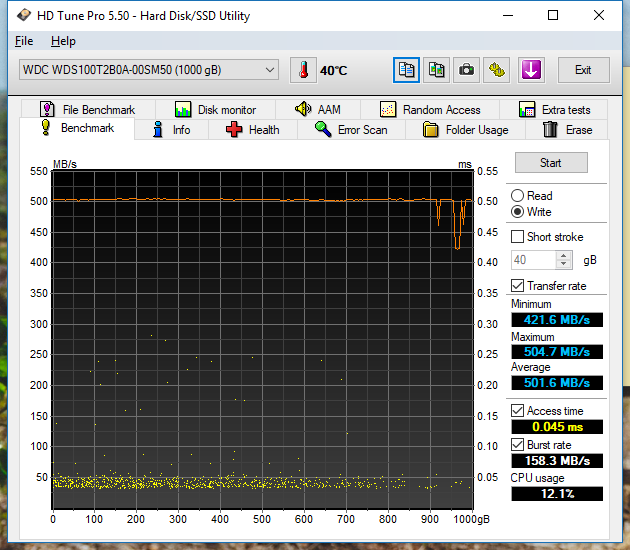HDTUNE
HD Tune is a Hard Disk Utility with many functions from error checking, health testing (S.M.A.R.T.), and of course benchmarking. To build upon our real world write test we also looked to see where the write speeds leveled off to by using HD Tune Pro. If SLC caching is being utilized, this test will typically show it.
WD
SanDisk
There you have it. For the most part, there is no write speed degradation. Only at the very end do we see the WD have a momentary dip to 425MB/s. Will this ever happen to us in the real world? Highly unlikely. That is after writing over 900GB of data straight to the drive. Who is going to do that, let alone do it often enough to where it matters?
REPORT ANALYSIS AND FINAL THOUGHTS

We have been nothing but impressed by both the WD Blue 3D SSD and the SanDisk Ultra 3D in today’s review. Bombarding these twins with benchmark after benchmark only helped to establish their rank as some of the best performing SATA 6Gb/s SSDs out. They reached their rated sequential read/write specs of 560/530MB/s with ease. Delivering up to 95K IOPS read and 84K IOPS write was a breeze. In PCMark 8 they both delivered similar performance with average throughput results of 296MB/s, which is just fantastic. During the extended run, they proved to us that their new, 64-layer BiCS 3D TLC NAND can provide more than ample performance and consistency for demanding workloads and give the Samsung 850 EVO a run for its money. During our 30GB write transfer, they delivered almost 540MB/s write performance and write speed degradation upon HDTune’s write fill appears to be almost non-existent. Best of all, write efficiency has improved greatly thanks to the new NAND. WD claimed just 25% improvement, but our testing shows an efficiency increase of 81%!

FINAL THOUGHTS
The WD Blue 3D SSD and the SanDisk Ultra 3D have a lot going for them. We must admit that at first, we did have our doubts about their performance. The utilization of a 4-channel controller and 3D TLC didn’t seem to make for a benchmarks leader. After the first round of testing, however, we were quickly shown otherwise. This combination proved to deliver great performance and efficiency that rivals some of the best SATA SSDs out. That alone could be enough for some to put it in their cart, but to top things off, the price is right and they keep oozing value. When you’re ready to check out one of these bad boys yourself, you really just need to see which is the cheaper of the two at the time. Although, do keep in mind that the WD Blue offers a bit more value with its compatibility with Acronis True Image WD Edition software and potentially an extra 2-years warranty coverage vs the SanDisk Ultra 3D.
With all that said, it is without a doubt that we award these two new SATA SSDs our Editor’s Choice Award. We couldn’t see it any other way.
Check Out the WD Blue 3D SSD at Amazon.
 The SSD Review The Worlds Dedicated SSD Education and Review Resource |
The SSD Review The Worlds Dedicated SSD Education and Review Resource | 

Great-With 3D reaching the market,perhaps the “race to the bottom” is over.
And we can send planer TLC and ram-less drives off to silicon heaven.
Pretty please, can we get a review of the 250 size.
Thanks
HOW will we know we are getting new stock rather than old slow stock?? is there a model number or suchlike? they are highly priced in the uk 90gbp for 250gb
Just look for “3D” when buying.
Shouldn’t they be called 3D SSDDD ?
Is there compatibility for Dell Inspiron 14 3421?